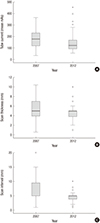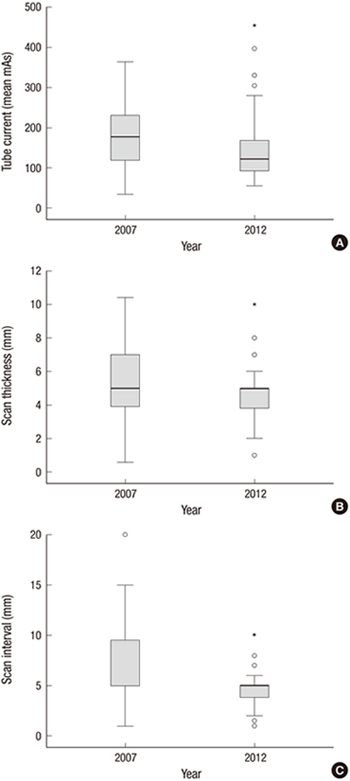1. Mettler FA Jr, Bhargavan M, Faulkner K, Gilley DB, Gray JE, Ibbott GS, Lipoti JA, Mahesh M, McCrohan JL, Stabin MG, et al. Radiologic and nuclear medicine studies in the United States and worldwide: frequency, radiation dose, and comparison with other radiation sources--1950-2007. Radiology. 2009; 253:520–531.
2. American College of Radiology. ACR practice guideline for the performance of pediatric and adult thoracic computed tomography(CT). accessed on 15 October 2015. Available at
http://www.acr.org.
3. Brenner DJ, Doll R, Goodhead DT, Hall EJ, Land CE, Little JB, Lubin JH, Preston DL, Preston RJ, Puskin JS, et al. Cancer risks attributable to low doses of ionizing radiation: assessing what we really know. Proc Natl Acad Sci U S A. 2003; 100:13761–13766.
7. Brenner DJ, Hall EJ. Computed tomography--an increasing source of radiation exposure. N Engl J Med. 2007; 357:2277–2284.
8. Hricak H, Brenner DJ, Adelstein SJ, Frush DP, Hall EJ, Howell RW, McCollough CH, Mettler FA Jr, Pearce MS, Suleiman OH, et al. Managing radiation use in medical imaging: a multifaceted challenge. Radiology. 2011; 258:889–905.
9. National Council on Radiation Protection and Measurements. Ionizing radiation exposure of the population of the United States: NCRP Report No.160. Bethesda, MD: National Council on Radiation Protection and Measurements;2009.
10. Hall EJ, Brenner DJ. Cancer risks from diagnostic radiology. Br J Radiol. 2008; 81:362–378.
11. Tsushima Y, Taketomi-Takahashi A, Takei H, Otake H, Endo K. Radiation exposure from CT examinations in Japan. BMC Med Imaging. 2010; 10:24.
12. Kim BH, Do KH, Goo HW, Yang DH, Oh SY, Kim HJ, Lee KY, Lee JE. National survey of radiation doses of pediatric chest radiography in Korea: analysis of the factors affecting radiation doses. Korean J Radiol. 2012; 13:610–617.
13. Tanimura M, Matsui I, Abe J, Ikeda H, Kobayashi N, Ohira M, Yokoyama M, Kaneko M. Increased risk of hepatoblastoma among immature children with a lower birth weight. Cancer Res. 1998; 58:3032–3035.
14. Shu XO, Potter JD, Linet MS, Severson RK, Han D, Kersey JH, Neglia JP, Trigg ME, Robison LL. Diagnostic X-rays and ultrasound exposure and risk of childhood acute lymphoblastic leukemia by immunophenotype. Cancer Epidemiol Biomarkers Prev. 2002; 11:177–185.
15. Shu XO, Jin F, Linet MS, Zheng W, Clemens J, Mills J, Gao YT. Diagnostic X-ray and ultrasound exposure and risk of childhood cancer. Br J Cancer. 1994; 70:531–536.
17. Goo HW. CT radiation dose optimization and estimation: an update for radiologists. Korean J Radiol. 2012; 13:1–11.
18. Kalra MK, Maher MM, Toth TL, Hamberg LM, Blake MA, Shepard JA, Saini S. Strategies for CT radiation dose optimization. Radiology. 2004; 230:619–628.
19. Singh S, Kalra MK, Moore MA, Shailam R, Liu B, Toth TL, Grant E, Westra SJ. Dose reduction and compliance with pediatric CT protocols adapted to patient size, clinical indication, and number of prior studies. Radiology. 2009; 252:200–208.
21. Shrimpton PC, Hillier MC, Meeson S, Golding SJ. Doses from computed tomography(CT) examinations in the UK: 2011 review. London: Public Health England;2014.
22. Brix G, Nagel HD, Stamm G, Veit R, Lechel U, Griebel J, Galanski M. Radiation exposure in multi-slice versus single-slice spiral CT: results of a nationwide survey. Eur Radiol. 2003; 13:1979–1991.
23. van der Molen AJ, Schilham A, Stoop P, Prokop M, Geleijns J. A national survey on radiation dose in CT in the Netherlands. Insights Imaging. 2013; 4:383–390.
24. Tsai HY, Tung CJ, Yu CC, Tyan YS. Survey of computed tomography scanners in Taiwan: dose descriptors, dose guidance levels, and effective doses. Med Phys. 2007; 34:1234–1243.
25. Suliman II, Abdalla SE, Ahmed NA, Galal MA, Salih I. Survey of computed tomography technique and radiation dose in Sudanese hospitals. Eur J Radiol. 2011; 80:e544–51.
26. Wambani JS, Korir GK, Onditi EG, Korir IK. A survey of computed tomography imaging techniques and patient dose in Kenya. East Afr Med J. 2010; 87:400–407.
27. Ogbole GI, Obed R. Radiation doses in computed tomography: need for optimization and application of dose reference levels in Nigeria. West Afr J Radiol. 2014; 21:1–6.











 PDF
PDF Citation
Citation Print
Print






 XML Download
XML Download